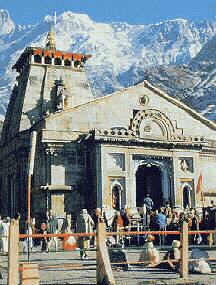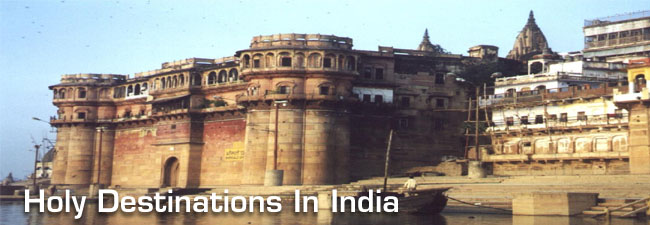 Kedarnath
Kedarnath
The Celestial Jyotirlinga
Amidst the dramatic mountainscapes of the majestic Kedarnath
range stands one of the twelve 'Jyotirlingas' of Kedar or Lord
Shiva. Lying at an altitude of 3584 mts. on the head of river
Mandakini, the shrine of Kedarnath is amongst the holiest pilgrimages
for the Hindus.
Kedarnath is a majestic sight, standing in the middle of a
wide plateau surrounded by lofty snow covered peaks. The present
temple, built in the 8th century by Adi Shankaracharya, stands
adjacent to the site of an earlier temple built by the Pandavas.
The inner walls of the assembly hall are decorated with figures
of various deities and scenes from mythology. Outside the temple
door a large statue of the Nandi Bull stands as guard.
Dedicated to Lord Shiva, the exquisitely architecture Kedarnath
temple is said to be more than a 1000 years old. Built of extremely
large, heavy and evenly cut gray slabs of stones, it evokes
wonder as to how these heavy slabs were handled in the earlier
days. The temple has a " Garbha Griha" for worship
and a Mandap apt for assemblies of pilgrims and visitors. A
conical rock formation inside the temple is worshipped as Lord
Shiva in his Sadashiva form.
History
According to legend, Lord Shiva wished to elude the Pandavas,
who had come to seek penitence for having killed their kin in
the battle of Kurukshetra. He took refuge in Kedarnath in the
form of a bull. Bhima, one of the Pandava brothers, found Shiva
amongst a herd of cattle. Having identified the meanest and
most arrogant of the herd as Shiva, Bhima is said to have grabbed
him by the hindquarters. What remains at the shrine in Kedarnath
is the rear end of the bull, with the rest of its body scattered
throughout the Garhwal. Shiva dived into the ground leaving
behind him a hump on the surface. This conical protrusion is
worshipped as the idol. It is the main site of the Panch Kedar
temples.
Four Other Kedars
Three of these (barring Kalpeshwar) are in mountain meadows
at higher altitudes than Kedarnath. The climb to Rudranath is
the most strenuous though worth the trouble, as this meadow
is one of the finest in Garhwal.
Mythological Myth
Legend has it that when the Pandavas sought penance following
the great war of the Mahabharata they came in search of Lord
Shiva. Arriving at this site they found that Shiva had elusively
taken the form of a bull. Bhim the strongest of the Pandavas
went after Shiva who dived deep into the ground. Only Shiva's
tail was left in Bhim's hand. This spot is known as the Kedarnath
and is also considered the main Kedar. The rest of Shiva's body
emerged at four other places in Garhwal - Tunganath, Madhyamaheshwar,
Kalpeshwar and Rudranath. These five Kedars are worshipped as
Panch Kedars.
Location & Access
Kedarnath is situated in the Uttar Kashi district of the northern
state of Uttaranchal. Very close to the Indo-Chinese border,
it is the source of the Mandakini River. It is couched in the
scenic locales of the Garhwal Himalayas at 3583 meters above
sea level. It is very cold in the winters with the ground being
covered with snow. In the summers, the mercury barely crosses
the 20?C mark. The place experiences about 150 cm of rainfall
during the monsoons and so the best time to visit is between
May and October. Kedarnath is near to Rishikesh (234 km) and
Dehradun (250 km).
An Important Note - During the winters, the shrine is submerged
in snow and hence is closed. The ideal time to visit is between
May to October. Kedarnath is reached through a 14 km long trek
from Gaurikund.
Location: Uttar Kashi, Uttranchal
Area: 3 sq. km.
Climate:
Winter: Sep. to Nov. cold during the day and chilly at night
Summer: May - August- Cool during the day and cold at night
Best Season: May to October except monsoon.
Accessibility
Airport - Jolly Grant, Dehradun (251 km)
Rail - Rishikesh (234 km), Kotdwar (260 km)
Road - Approachable on foot from Gaurikund, which is connected
by road to Rishikesh, Kotwar, Dehradun, Haridwar and other important
hill stations of Garhwal and Kumaon region.
Pilgrimage Attractions in Kedarnath
Kedarnath Temple
The present temple, built in 8th century A.D. by Adi Guru Shankaracharya
lies adjacent to the site of an ancient temple built by Pandavas.
The walls of the exquisitely architectured temple are embellished
with figures of deities and scenes from mythology. The temple
has a conical lingam - the main idol, a statue of Nandi - the
celestial bull, a 'garbha grab' for worship and a 'mandap' for
assemblies of piligrims and visitors. The temple is believed
to be more than 1000 years old.
Shankaracharya Samadhi
Behind the Kedarnath Temple lies the samadhi or the final resting
place of Adi Guru Shankaracharya. It is believed, after establishing
the four dhams in India, he went for his samadhi at an early
age of 32 years.
Excursions
Chorabari (Gandhi Sarovar) (2 km)
A small lake from where Yudhishthir, the eldest of the Pandavas,
is believed to have departed to heaven. The floating ice on
the sparkling waters of the lake is a fascinating sight.
Vasuki Tal (6 km)
A picturesque lake, 4,135 mt above sea level is encircled by
lofty mountains and offers a commanding view of the Chaukhamba
peaks.
Gaurikund (14 km)
The trekking base to Kedarnath. A temple dedicated to Gauri
and thermal springs of medicinal value are noteworthy.
Sonprayag (20 km)
The confluence of Son Ganga and Mandakini rivers. The road
to Triyuginarayan diverts from here.
Triyuginarayan (25 km)
A 5 km trek from Sonprayag, it is the mythological venue of
the marriage of Lord Shiva and Goddess Parvati. An eternal flame,
which is said to have been a witness to the marriage, burns
in front of the temple even today.
Guptkashi (49 km)
The temples of Ardhnarishwar and Vishwanath are noteworthy.
Ukshimath (60 km)
Winter home of the deity of the Kedarnath Temple and the seat
of the Rawal of Kedarnath.
Agastyamuni (73 km)
Famous for the temple dedicated to sage Agastya.
Chandrashila (93 km)
The Chandrashila peak provides a rare view of snow-clad peaks.
The rhododendron Forests and alpine meadows dominate the trek
from Tungnath to Chandrashila.
Deoria Tal (68 km)
Sari village is the last bus terminus on Chopta-Ukhimath road
from where a 2 km trek leads to Deoria Tal. This beautiful lake
at an altitude of 2,438 mt gives the spectacular reflection
of snow-capped peaks in the lake water. Ideal spot for angling
and bird watching.
